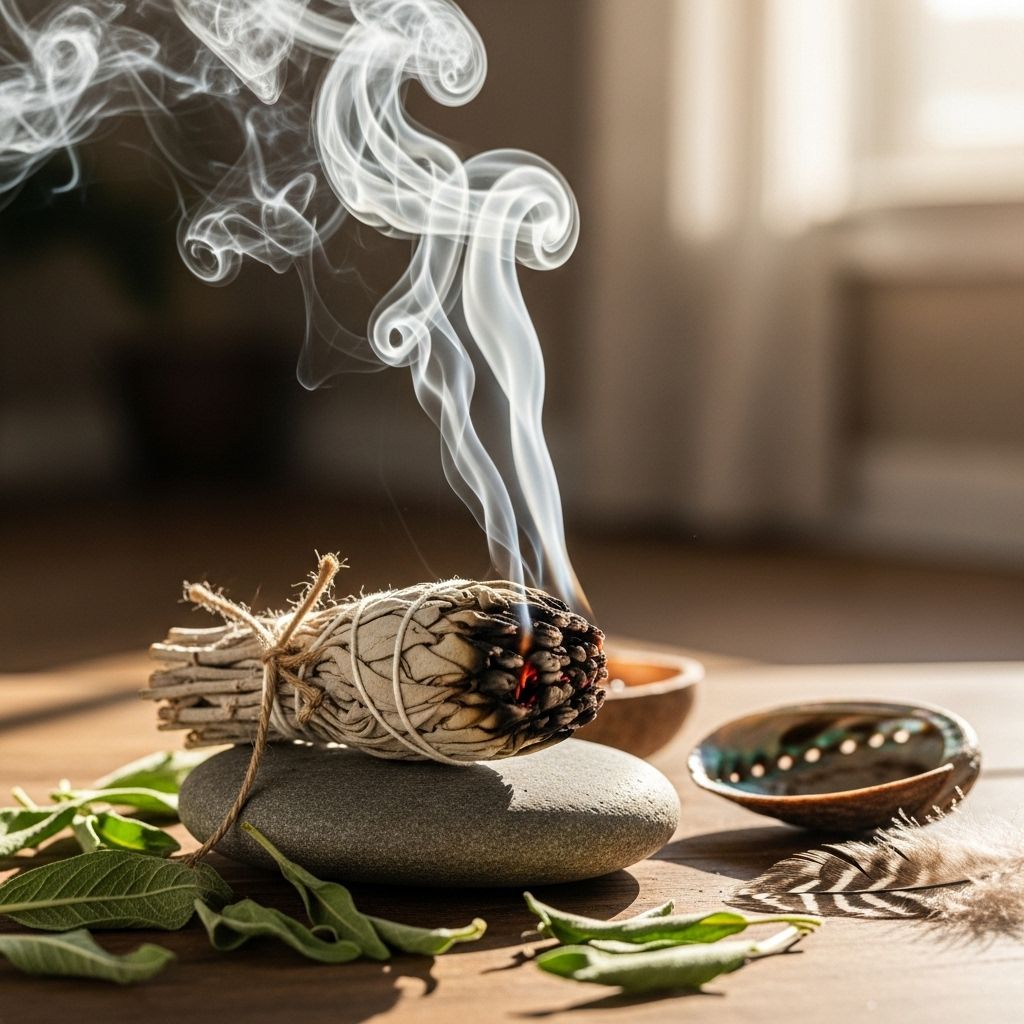The Benefits of Burning Sage: Ancient Practice, Modern Wellness
Discover how the ancient ritual of sage burning can purify your space and enhance well-being

Burning sage, also known as smudging, is an ancient spiritual practice that has been used for centuries across various cultures, particularly within Native American traditions. This ritual involves burning dried sage leaves and allowing the fragrant smoke to permeate a space, person, or object with the intention of cleansing and purification. While rooted in spiritual and ceremonial practices, modern research has begun to explore the potential scientific benefits behind this age-old tradition, revealing that there may be more to sage burning than meets the eye.
The practice of smudging has experienced a resurgence in popularity as people seek natural methods to improve their living environments and overall well-being. From purifying the air to enhancing mental clarity and reducing stress, sage burning offers a range of potential benefits that bridge ancient wisdom with contemporary wellness practices. Understanding both the traditional significance and modern scientific perspective of this practice can help you incorporate it meaningfully and safely into your own life.
Understanding Sage and Smudging
Sage belongs to the Salvia plant family, a name derived from the Latin word “salvere,” which means “to heal.” This etymological connection hints at the plant’s long history of medicinal and therapeutic use across multiple civilizations. White sage, scientifically known as Salvia apiana, is the most commonly used variety for smudging practices, though other types such as white prairie sage (Artemisia ludoviciana) and garden sage (Salvia officinalis) are also utilized for similar purposes.
The tradition of burning sage has deep roots in various cultural practices. Native American communities have used smudging ceremonies for spiritual purification, healing rituals, and blessing ceremonies for generations. Similarly, ancient civilizations in Egypt, Rome, and Greece incorporated sage into their medical and spiritual practices, recognizing its unique properties long before modern science could explain them.
Smudging typically involves bundling dried sage leaves together, lighting one end, and then gently blowing out the flame to allow the bundle to smolder and produce aromatic smoke. This smoke is then directed around a person, throughout a space, or over objects with intentional movements, often accompanied by prayers, affirmations, or meditative practices that enhance the ritual’s spiritual significance.
Air Purification and Antimicrobial Properties
One of the most scientifically supported benefits of burning sage relates to its antimicrobial properties. Research has demonstrated that certain types of sage possess powerful antibacterial, antiviral, and antifungal qualities that can significantly impact the quality of indoor air.
Studies have shown that burning sage can reduce airborne bacteria by more than 94 percent, making it a remarkably effective natural air purifier. White prairie sage and white sage both exhibit antimicrobial properties that help keep infectious viruses, bacteria, and fungi at bay. This scientific validation supports the traditional belief that smudging cleanses spaces of harmful microorganisms and creates a healthier environment.
The antimicrobial smoke works by releasing compounds into the air that actively combat various pathogens. When sage burns, it releases negative ions—though this aspect requires further experimental confirmation—which are believed to help neutralize positive ions commonly associated with allergens such as mold, pet dander, dust, and pollution. By reducing these airborne irritants, sage burning may contribute to improved respiratory health and overall air quality in indoor environments.
However, it’s crucial to recognize that while burning sage purifies the air, the smoke itself can be problematic for individuals with respiratory conditions. People with asthma, allergies, bronchitis, or other breathing difficulties should exercise caution when smudging, as inhaling smoke can exacerbate symptoms. The recommended practice is to allow the smoke to dissipate and the room to air out before entering, ensuring that the purification benefits are realized without causing respiratory distress.
Natural Insect Repellent
Beyond its antimicrobial properties, sage also functions as an effective natural insect repellent. Both white sage and white prairie sage have been documented to repel insects, making smudging a practical solution for those seeking chemical-free alternatives to conventional bug sprays and repellents.
This insect-repelling quality has been utilized traditionally to keep unwanted pests away from living spaces and ceremonial areas. The strong, distinctive aroma of burning sage appears to deter various insects, creating a more comfortable and pest-free environment. This benefit makes sage burning particularly appealing during warmer months when insect activity increases, offering a natural and aromatic alternative to synthetic chemical repellents that may contain potentially harmful ingredients.
Mood Enhancement and Emotional Well-Being
Traditional wisdom has long held that burning sage can lift one’s spirits and banish negativity, and modern research is beginning to support these claims. A 2014 study documented white prairie sage, also known as estafiate, as an important traditional remedy for treating anxiety, depression, and mood disorders in certain cultures.
The mood-enhancing properties of sage appear to be linked to specific chemical compounds found in the plant. A 2016 research project conducted by the University of Mississippi established that white sage is rich in compounds that activate certain receptors in the brain. These receptors are responsible for elevating mood levels, reducing feelings of sadness or negativity, and promoting overall emotional balance.
The ritual aspect of smudging may also contribute to its mood-boosting effects. The intentional act of cleansing one’s space, combined with the aromatic experience and meditative quality of the practice, can create a sense of renewal and positivity. Many practitioners report feeling lighter, more optimistic, and emotionally refreshed after a smudging session, suggesting that both the chemical properties of sage and the mindful practice itself work synergistically to enhance emotional well-being.
Stress Reduction and Anxiety Relief
Closely related to its mood-enhancing properties, sage burning has shown promise as a natural stress reliever. The same brain receptors that elevate mood also play a role in reducing stress and promoting relaxation. When activated by compounds in sage smoke, these receptors can help calm the nervous system and create a sense of tranquility.
The act of smudging can serve as a form of mindfulness practice, requiring presence, intention, and focus. This meditative quality naturally reduces stress by pulling attention away from worries and into the present moment. The soothing aroma of sage smoke further enhances this calming effect, engaging the olfactory system in a way that signals the brain to relax.
For those dealing with chronic stress or anxiety, incorporating sage burning into a regular self-care routine may provide gentle, natural relief. While it shouldn’t replace professional mental health treatment when needed, smudging can complement other stress management techniques such as meditation, deep breathing exercises, and relaxation practices.
Cognitive Enhancement and Mental Clarity
One of the more intriguing benefits of sage involves its potential to enhance cognitive function. Research suggests that sage may have cognitive-enhancing properties, with particular promise for conditions affecting memory and mental processing.
A 2005 study found that standard sage oil improved memory and cognition, with increased dosages being connected to better mood, attentiveness, tranquility, and feelings of happiness. These findings suggest that the compounds in sage may protect against neurological diseases such as Alzheimer’s and dementia, though more research is still needed to fully understand these protective mechanisms.
A 2016 review of studies examining Salvia’s cognitive-enhancing benefits showed promising evidence, suggesting potential applications in treating dementia and Alzheimer’s disease. The properties of sage used in smudging have been shown to improve memory, focus, and mental clarity, making it a popular practice among those seeking natural ways to enhance cognitive performance.
Many practitioners report experiencing heightened awareness, sharper thinking, and improved concentration after smudging sessions. Whether these effects result from the chemical compounds in sage smoke, the mindful nature of the ritual, improved air quality, or a combination of factors, the cognitive benefits add another dimension to sage burning’s therapeutic potential.
Improved Sleep Quality
Quality sleep is essential for overall health and well-being, and burning sage has been traditionally used to safeguard against negativity that could interfere with rest. Some studies suggest that sage contains compounds that may help with insomnia and promote better sleep.
Garden sage (Salvia officinalis), which is sometimes used similarly to white sage, has been utilized to help people sleep better and achieve deeper relaxation. The stress-reducing and mood-enhancing properties of sage likely contribute to its sleep-promoting effects, as lower stress levels and improved emotional states naturally facilitate better rest.
The calming ritual of smudging before bedtime can also serve as an effective wind-down practice, signaling to the body and mind that it’s time to transition from the activities of the day to a state of rest. The aromatic experience combined with the meditative quality of the practice creates an environment conducive to relaxation and sleep.
Energy Cleansing and Spiritual Benefits
While scientific research continues to explore the measurable benefits of sage burning, the practice’s spiritual and energetic dimensions remain important to many practitioners. According to alternative medicine perspectives and traditional wisdom, burning sage can help release negative energy from spaces, objects, and individuals.
The concept of energetic cleansing suggests that environments can accumulate stagnant or negative energy over time, particularly in spaces where conflict, illness, or difficult emotions have occurred. Smudging is believed to clear this energetic residue, creating a fresh, renewed atmosphere. While these effects may be difficult to measure scientifically, many people report feeling a tangible shift in the energy of a space after smudging.
This spiritual dimension of sage burning is particularly valued when moving into a new home, after an argument or period of stress, during life transitions, or when seeking to create sacred space for meditation, yoga, or other spiritual practices. The intention brought to the smudging ritual is considered as important as the physical act itself, with many traditions emphasizing the power of focused thought and prayer during the ceremony.
Cleansing Objects and Secondhand Items
Beyond purifying spaces and people, sage burning can be used to cleanse specific objects. This practice is particularly useful with new purchases, gifts, or secondhand items that may carry unknown history or energy.
The process involves directing sage smoke around and over the object with intention, symbolically clearing away any energetic imprints from previous owners or experiences associated with the item. This can bring peace of mind and help make objects feel more personally sacred or meaningful. Whether dealing with antique furniture, inherited jewelry, or any item with uncertain provenance, smudging offers a way to energetically claim and purify possessions.
Potential Energy Boost
Many practitioners report feeling more energized after smudging sessions. By clearing away negative energy from the body, objects, and spaces, sage burning is believed to help welcome newer, fresher, and more positive energies. This energetic renewal can, in some ways, be invigorating and may help combat feelings of fatigue or sluggishness.
The energy-boosting effect may result from multiple factors: improved air quality leading to better oxygen flow, the mood-enhancing and stress-reducing properties of sage, the physical act of moving through space during the smudging ritual, and the psychological impact of performing an intentional cleansing practice. While the concept of energy cleansing may be more metaphorical than literal from a scientific standpoint, the subjective experience of feeling revitalized after smudging is widely reported.
How to Practice Smudging Safely
For those interested in incorporating sage burning into their wellness routine, understanding proper technique and safety precautions is essential. Here are key guidelines for safe and effective smudging:
Preparation: Begin by gathering your materials. You’ll need a sage bundle (often called a smudge stick), a heat-resistant container such as an abalone shell or ceramic bowl to catch ashes, and matches or a lighter. Open windows and doors to allow smoke to escape and fresh air to circulate.
Lighting the Sage: Hold the sage bundle at a 45-degree angle and light one end. Allow it to burn for about 20-30 seconds, then gently blow out the flame so the sage smolders and produces smoke rather than burning with an open flame.
Smudging Yourself: Direct the smoke around your body, starting at your feet and moving upward, or beginning at your head and moving downward. Use your hand or a feather to guide the smoke. Focus on areas where you hold tension or feel you need cleansing.
Smudging Spaces: Walk slowly through your space, allowing smoke to reach corners, doorways, windows, and areas where energy feels stagnant. Move clockwise around rooms if following traditional practices, though this varies by cultural tradition.
Smudging Objects: Hold objects in the smoke or direct smoke around and over them, turning them to ensure all sides are exposed to the sage.
Setting Intentions: Throughout the process, maintain focus on your intention for the smudging. This might include affirmations, prayers, or simply holding thoughts of cleansing and renewal in your mind.
Extinguishing the Sage: When finished, press the burning end of the sage bundle into sand, soil, or your heat-resistant container to completely extinguish it. Never leave smoldering sage unattended.
Important Safety Considerations
While sage burning offers numerous benefits, certain precautions must be observed to ensure safe practice. Always burn sage in a well-ventilated area with windows or doors open. Never leave burning sage unattended, and keep it away from flammable materials such as curtains, papers, or fabrics.
Individuals with respiratory conditions including asthma, bronchitis, allergies, or COPD should exercise extreme caution, as smoke inhalation can trigger or worsen symptoms. These individuals might consider sage sprays or other smokeless alternatives to achieve similar energetic effects without respiratory risks.
Pregnant women should consult healthcare providers before engaging in smudging practices. Additionally, be mindful of pets, as smoke can be irritating or harmful to animals with sensitive respiratory systems.
Fire safety is paramount. Always have water or sand nearby to extinguish sage completely, and ensure the bundle is fully extinguished before storing it or disposing of ashes.
Cultural Sensitivity and Respect
As sage burning gains mainstream popularity, it’s important to approach the practice with cultural sensitivity and respect. Smudging is a sacred ceremony in many Native American traditions, and the commercialization of white sage has raised concerns about cultural appropriation and environmental sustainability.
Consider sourcing sage ethically from suppliers who harvest sustainably and respect indigenous practices. Some practitioners choose to grow their own sage or purchase from indigenous-owned businesses. Approach the practice with reverence and intention rather than treating it as a trend or aesthetic choice.
Learning about the cultural origins and traditional meanings of smudging deepens the practice and honors the wisdom of the cultures from which it originates. This respectful approach enriches the experience while supporting indigenous communities and preserving sacred traditions.
Alternatives and Complementary Practices
For those who cannot burn sage due to respiratory sensitivities or living situations where open flames aren’t permitted, alternatives exist. Sage sprays made with essential oils and water can provide energetic cleansing without smoke. Essential oil diffusers with sage oil offer aromatic benefits without combustion.
Other herbs used for smudging include cedar, sweetgrass, lavender, rosemary, and palo santo, each carrying its own properties and traditional uses. Experimenting with different herbs can help you find the most effective and personally resonant options for your practice.
Frequently Asked Questions
Q: How often should I burn sage?
A: There’s no prescribed frequency for sage burning. Many people smudge weekly as part of regular space clearing, while others do so during specific occasions such as moving homes, after illness, or during seasonal transitions. Listen to your intuition about when your space feels like it needs energetic refreshing.
Q: Can burning sage really kill 94% of bacteria in the air?
A: Research has shown that medicinal smoke from burning sage can reduce airborne bacteria by more than 94 percent. However, this effect is temporary, and bacteria will eventually return to normal levels. Regular smudging combined with other cleaning practices provides the best results for maintaining air quality.
Q: Is it safe to burn sage around pets?
A: Smoke can be irritating to pets, particularly birds, cats, and small animals with sensitive respiratory systems. If smudging around pets, ensure excellent ventilation and consider moving animals to another room during the practice. Watch for signs of distress and discontinue if pets show discomfort.
Q: What’s the difference between white sage and other types of sage?
A: White sage (Salvia apiana) is traditionally used in Native American smudging ceremonies and has strong antimicrobial properties. Garden sage (Salvia officinalis) is the culinary variety also used for smudging with similar but slightly different properties. White prairie sage (Artemisia ludoviciana) is another traditional smudging herb. Each type has unique characteristics, though all offer cleansing benefits.
Q: Can sage burning help with depression and anxiety?
A: Research suggests sage contains compounds that may help improve mood and reduce stress by activating certain brain receptors. However, sage burning should not replace professional mental health treatment. It can be used as a complementary practice alongside therapy and prescribed treatments for anxiety and depression.
Q: Why do I need to open windows when smudging?
A: Opening windows serves two purposes: it allows negative energy to exit (according to spiritual belief) and ensures proper ventilation to prevent smoke buildup and maintain air quality. Good airflow protects respiratory health while still allowing the cleansing benefits of the practice.
References
- https://www.resurchify.com/blog/article/10-benefits-of-burning-sage-how-to-211
- https://www.goodnet.org/articles/5-ways-smudging-clears-air
- https://www.healthline.com/health/benefits-of-burning-sage
- https://www.pure-therapy.co.uk/the-purpose-and-benefits-of-smudging/
- https://www.youtube.com/watch?v=x3ODfFI35A0
- https://bellasmiracleshop.com/blogs/articles/benefits-and-properties-and-meaning-of-sage-burning-smudging
- https://www.webmd.com/diet/health-benefits-sage
Read full bio of medha deb












